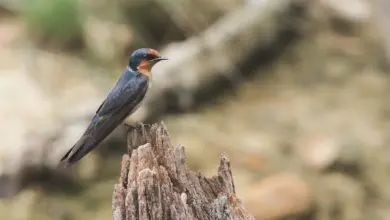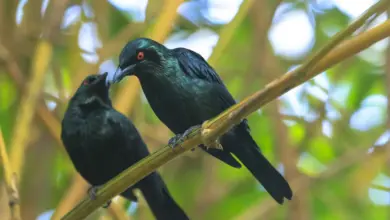Dark Eyed Junco Male Vs. Female: Differences ; How To Identify
In this article, I look at how to differentiate between male and female dark-eyed juncos in terms of morphology and behavior
Do you know what the most common forest bird is in North America?
The dark-eyed junco (Junco hyemalis) is a sparrow-like songbird found in the continent’s conifer and mixed forests where it nests.
Famously, it visits towns in the winter (especially under the birdfeeders), earning the nickname “snowbird.”
Experts say the North American dark-eyed junco population numbers as many as 630 million individuals!

Like with many other birds, dark-eyed juncos display sexual dimorphism (apparent differences between male and female juncos).
Although they look similar, boy and girl juncos are distinctly colored (and it’s not blue vs. pink).
And that’s not the only difference – it turns out that male and female dark-eyed juncos vocalize differently, behave differently, and sing differently.
Why would I want to know the differences between dark-eyed junco sexes?
Unfortunately, the junco’s great numbers do not prevent them from becoming endangered in the future.
Like many other bird species, juncos are facing a rapid decline, so we definitely shouldn’t take this lovely ball of feathers for granted.
Even though the population of wild birds is in a bad place right now, the public interest in conservation is growing, directly and indirectly helping conservation efforts.
Citizen science and birdwatching are the most important activities in that context, allowing ornithologists to gather more data from field observations than ever before.
If you want to be a pro birdwatcher who can truly contribute to bird science, learning the differences between males and females is essential.
Since these are wild birds, I will focus here on the distinctions that can be studied even from afar.


Dark-Eyed Junco Male and Female – Morphology and Color
Now, I’ll describe the specific looks of dark-eyed juncos – both males and females.
Due to practical reasons, we’ll consider the most obvious traits – colors and morphology.
Believe it or not, the Dark-eyed junco species is a “complex” with 13 local variants or subspecies.
Here, I’ll cover the most common variants – the Slate-colored junco that inhabits most of eastern North America and the Oregon Dark-Eyed Junco with its subtypes, more common in the west.
For starters, here are the common features that both males and females of all dark-eyed junco subspecies share:
- A medium-sized sparrow-like body with a rounded head.
- A long tail with white outer feathers (inconspicuous when the bird is grounded but visible during flight).
- A small pale bill, and
- Dark eyes (shout-out to Captain Obvious!)
- The males and females are of the same size.
Dark-Eyed Junco Male
Slate-colored dark-eyed junco male (Junco hyemalis hyemalis) is the species’ stereotype in popular culture – a bird nearly everyone imagines when you mention the dark-eyed junco.
It is commonly observed in the northeast and in southern locations (also mostly east) when the winter hits.


Its specific features are:
- Grey upper (dorsal) side of the body. The head can have a darker shade than the rest – something like charcoal gray – and the feathers seem to have a velvety texture.
- White belly.
- Outer tail feathers are prominently white, and males display these feathers during courtship by spreading the tail.
Appalachian junco (J. h. carolinensis) is a subspecies from the Slate-colored junco group, but the differences are only subtle.
Oregon dark-eyed junco (Junco hyemalis oreganus) is familiar in Western states.
The Oregon junco male has:
- Dark brown, nearly black head (the “hood”)
- Light brown back.
- Buff brown sides.
- White belly.
All of the following subspecies belong to the Oregon junco group, and the males look like this:
- Pink-sided junco (J. h. mearnsi) is found in the Rockies; the male has a slate-grey head (“hood”), latte-brown back, and pinkish sides.
- Red-backed junco (J. h. dorsalis) is found in the Southwest. The male has a gray head with a darker face (smokey eyes, anyone?) and a rusty-brown-red patch on the back. Also, the upper portion of the bill is darker than the lower.
- Male grey-headed junco (J. h. caniceps) has – you’ve guessed it – a gray head with a dark face and a rust-colored patch on the back. It looks quite like the red-backed variant, but it has a fully pale bill, no darker upper side.
- White-winged junco male (J. h. aikeni) looks quite like the slate-colored junco but has an upper side that is of a slightly paler shade of gray, with a stretch of darker, nearly black color across the eyes. Also, it has white wingbars on the sides
Cassiar Junco (J. h. cismontanus) is probably the rarest and the most elusive subspecies on the list; some consider it a mere hybrid of the Slate-colored and Oregon junco.
In any case, the male Cassiar looks much like the Oregon junco but with fewer red and yellow overtones.
The head is dark brown, the backs are grayish-brown, and the belly is white (but not glistening white).


Dark-Eyed Junco Female
Like in the case of many other birds, dark-eyed junco females have a more dull coloration.
In bird species where males compete for females’ attention, having brighter or more contrasting plumage is a part of the evolutionary race to win them over, along with singing.
Better coloration and vocal performances promise better reproductive success.
- The color shades and patterns of the slate-colored junco females can vary, but one feature is certain – they are much browner than males, and that’s the most obvious distinction.
- Females of Oregon-type juncos look a bit like washed-out males. They have a lighter hood – sometimes much lighter – and brown back and sides. In general, they have less contrast than males.
Dark-Eyed Junco Females Vs. Juveniles
Telling females apart from juveniles is especially tricky with dark-eyed juncos (and with many other sparrows as well).
In juveniles, there are no sex differences in color, and the youngsters tend to be almost identically colored as adult females – varying shades of brown and no contrast.
However, young birds tend to be more streaky (especially on the chest) and appear to have thinner bills.
For detailed images of these differences between male, female, and juvenile dark-eyed juncos of various types, check out the Cornell Lab’s gallery.


Distinctions From Other Junco Species
Although their wintering ranges can overlap and look similar – especially the red-backed dark-eyed junco), the Yellow-eyed juncos are a separate species.
As the names suggest, the most notable difference is the eye color. However, the male and the female yellow-eyed junco do not differ in this aspect.
Although this would be a rare sight, if you see a red-backed dark-eyed junco and a yellow-eyed junco together, never conclude they are the same species.
Male Vs. Female Junco Behavioral Differences
Most commonly, you will observe a dark-eyed junco flock foraging, with no differences between males and females for the most part. However, some moments may give them away.
During the winter, when dark-eyed juncos form mixed groups, adult males tend to be more aggressive than females and young birds.
If you see a dark-eyed junco trying to drive away other birds from his own flock to get the best bits of food for himself, it is almost certainly a male.
During the breeding season, identifying male juncos becomes easy.
Only males are territorial and defend (or announce) their territory by perching on the highest point and singing.
Females are fairly inconspicuous in this period and do not engage in similar behavior.
Speaking of singing, did you know that male and female dark-eyed juncos vocalize differently?
Vocalization
Juncos seem to chatter constantly. During feeding, you will hear them chirp or make higher-pitched alarm calls before they fend for the safety of shrubs when disturbed.
Both sexes do this.
However, female dark-eyed juncos don’t make sounds more complicated than that. Simple chirps are their most common call.
On the other hand, males can really sing – mostly in the form of thrills. The dark-eyed junco thrill is even and sounds a bit like an old-school sci-fi sound effect.
They can also get vocal in other ways – for example, by doing louder, deeper bursts of chirping (often also targeted at the female).
Here is a good comparison of junco male vs. female vocal abilities.
Mating Behavior
After singing just the right song, the male will start his courtship dance.
He flashes the white tail feathers by spreading the tail and moving it up and down. He also vocalizes using both singing and chirping.
Males also spread their wings slightly (like in that first singing video) while doing thrills and courtship calls.
Females don’t have a particular ritual to offer in reply (at least not visible to us), so if you’re lucky to witness dark-eyed junco courtship, it’s an easy way to tell the male and the female apart.
Nesting and Feeding Behavior
At the beginning of their nesting period, males and females have different sets of duties.
Having formed a monogamous pair after successful courtship, the female will take charge – she will build the nest and incubate the eggs.
If you see a junco sitting on the nest – it is certainly a female (but please don’t disturb her by taking photos or otherwise).
The male’s task is to help find the right nesting materials and feeds the female while she’s sitting on the eggs.
After the chicks hatch, both parents take turns feeding them before they fledge after 9-13 days.
Frequently Asked Questions
Do male and female dark-eyed junco differ in size?
Both sexes lie somewhere between 5.1 to 6.9 inches long and have similar wingspans between 7.1 and 9.8 inches. They even weigh about the same.
The female has a slightly more slender (dare I say feminine?) neck, but it is not easy to pick up on it from a distance.
Do female juncos sing?
They usually voice their concerns over potential dangers while their flock is foraging on the ground. Only the males really sing – most commonly using thrills.
In 2017, however, some new research showed that it is possible for female dark-eyed juncos to sing in the wild as well. Since then, the behavior appears to be observed more often.
Scientists suspect that changes in habitat and global warming are causing some species of juncos to lose their migratory nature.
When this happens, it is possible for the females to gain their song once again.
Are there different types of juncos?
Of these, only two are present in North America.
All the dark-eyed junco subspecies are grouped within the Junco hyemalis species complex.
Do male juncos sit on the nest?
However, the male will ensure she’s well-fed while incubating the eggs. After the chicks hatch, the pair will share their parental responsibilities equally.
Where do junco birds sleep at night?
Conifer trees are their favorite roosting spot. These evergreens offer them respite from the winter cold.
Wrap Up
Male and female dark-eyed juncos differ in color, behavior, and vocalization. It will probably be easy for you to tell them apart, even if you’re an amateur birdwatcher.
On the other hand, dark-eyed junco sexes do not differ in size or general morphology (body shape and features).
However, the number of local dark-eyed junco variants and their subtle differences could make differentiation trickier. Try to remember the traits of the most common subspecies, especially those known to visit your area.
I hope you have enjoyed another lesson on the fabulous juncos. If you liked it – share it around!




